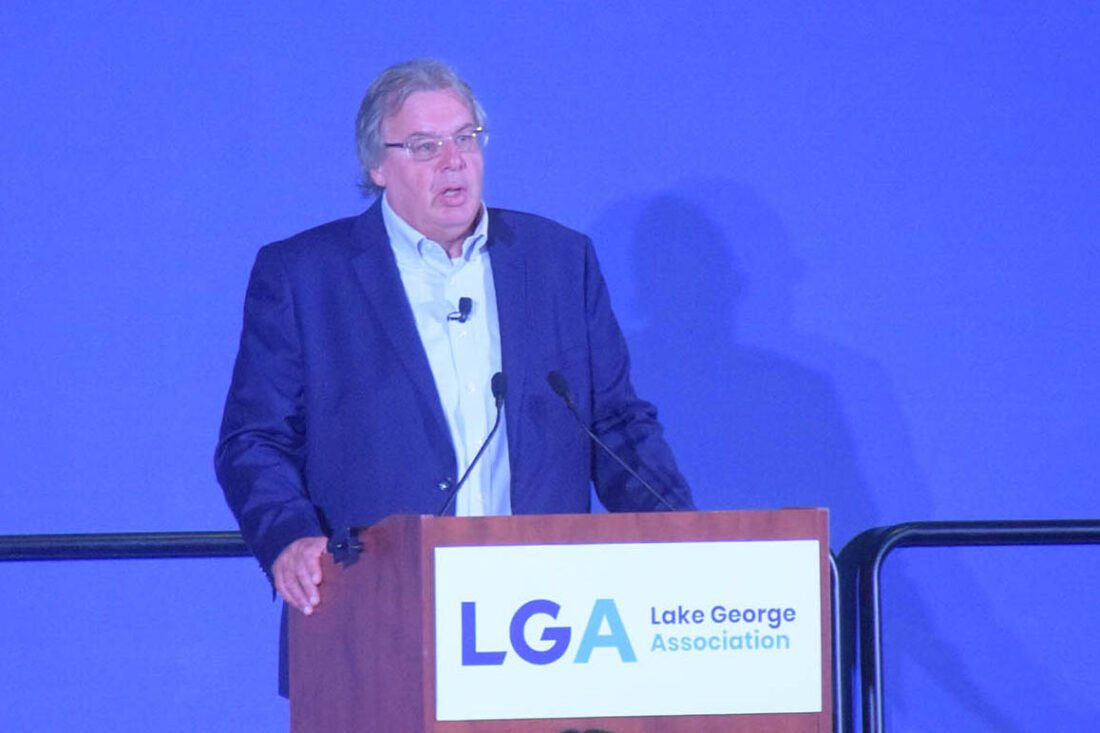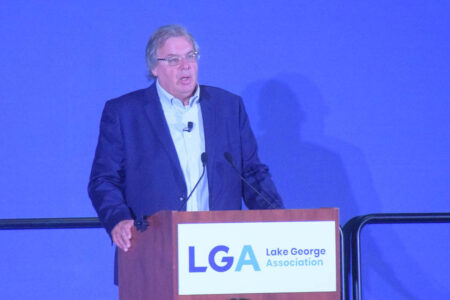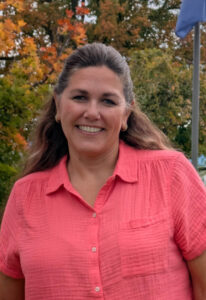Regional road salt summit set for Sept. 24
Conference highlights research, technology, practices around reducing salt use

Lake George Waterkeeper Chris Navitsky addresses the 2024 Adirondack Champlain Regional Salt Summit, which was held in Lake Placid that year. This year’s summit is slated for Sept. 24 in Lake George. (Enterprise photo — Chris Gaige)
LAKE GEORGE — The Adirondack Champlain Regional Salt Summit is slated to return for its 10th year on Sept. 24 at the Fort William Henry Conference Center in Lake George.
The summit focuses on road salt reduction and best practices for both public and private surface applicators. It’s hosted by the Lake George Association, a nonprofit environmental group that studies and advocates for clean and clear water for Lake George. The conference includes concurrent sessions of academic research presentations and surface treatment training classes, focusing those research and reduction efforts on Lake George, the Adirondacks and the Lake Champlain basin as a whole.
The event is free, and anyone interested in attending is welcome, though registration is required by Sept. 19. That can be done online at tinyurl.com/bddrkyxx. The summit will be held at the Fort William Henry Hotel. It will also be recorded and posted online several days later.
Chris Navitsky is the LGA’s Lake George Waterkeeper, a position that oversees water quality monitoring and is tasked with developing solutions to various issues facing the watershed, including salt reduction. Navitsky is also in charge of organizing the annual salt summit.
He said the summit presents a rare opportunity for road salt reduction stakeholders — everyone from residents who’ve seen their water quality impacted by road salt contamination to municipal and state highway personnel to private contractors to scientists and engineers — to come together, share their experiences and gain insights from one another.
Navitsky said people from outside the region, such as New Hampshire and Wisconsin, will also be at the conference to share what successes and issues they’ve had with road salt. Navitsky just came back from presenting at the New Hampshire Salt Symposium and was glad that some of the conference’s presenters will, in turn, be coming to Lake George.
“We are excited to have that cross-pollination between two of the better-known salt conferences,” he said.
Headlining the scientific research at the conference this year is Dr. James Sutherland. He’ll be presenting on his adaptation of the Modeling of Acidification of Groundwater in Catchment (MAGIC) model to assess road salt impacts. The MAGIC model was originally developed in the 1980s as a way to test acid rain impacts on an ecosystem.
It uses soil and water samples to count, among other signatures, certain elements’ cations, such as calcium and magnesium. As soils became more acidic, those tend to be displaced, providing a way for researchers to determine — by observing and comparing cation counts in the samples — how much an area is being impacted by acid rain, as well as to see if remediation efforts have reserved the impacts.
Navitsky said Sutherland has applied that principle to monitor salt levels, and has 55 years of data he’s collected from the Lake George watershed.
“He’s used that same type of modeling program for road salt to see how watersheds have responded to changes in road salt,” he said. “They release kind of the same (elements). … By checking those cations in the waters, we can see how road salt is impacting our groundwater and our soil.”
Navitsky noted that Sutherland’s research has shown a positive trend in Lake George, when it comes to salt levels, over the last 10 years. He said some of it was due to climate change — warmer and shorter winters requiring less salt application — but much of the success has come from salt reduction efforts, particularly from changes in practices at the municipal level.
There will also be an update on LGA and partner organizations’ advocacy in Albany. Navitsky recently took part in a road salt reduction roundtable hosted by state Assemblyman Bill Magnarelli, D-Syracuse, who chairs the Assembly’s Transportation Committee. More information on that roundtable can be found at tinyurl.com/npz54976.
Navitsky said he pressed the state Department of Transportation for more transparency on road salt application rates, noting that LGA has had to make Freedom of Information Law requests to obtain the information. The Adirondack Road Salt Reduction Task Force report, released in 2023, recommended making a number of data points around road salt application rates and frequencies publicly available.
A major component of reducing road salt is having concrete numbers on how much is being put on roadways, Navitsky said, and FOIL requests lead to lengthy response times and formatting that is cumbersome for researchers to distill.
“When we’ve gotten the most recent batch of data — which covered the past three winters — each year it’s in a different format,” he said. “For us, trying to interpret that, we don’t want to make a mistake and spend time to put out a report on something that’s invalid.”
Navitsky said Magnarelli seemed responsive to and upset by the difficulty LGA has faced in getting the information and hoped that action would be taken. He added that advocating for road salt reduction is hard work, as it often pushes against the status quo.
“So this is a time for us to celebrate,” Navitsky said. “Celebrate the work that we’ve done here in Lake George, which has resonated throughout the park. It’s a lot of hard work by our municipalities, and every once in a while, you’ve got to take time to celebrate that and recognize the accomplishments that we’ve done.”





